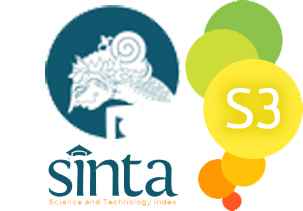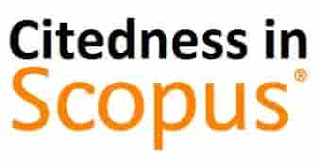Antibacterial Activity Test of Secang Wood (Caesalpinia sappan L.) Ethanolic Extract against Staphylococcus aureus
Abstract
Piogenic infection is an infection characterized by the occurrence of severe local inflammation with pus formation (pus). Generally caused by piogenic germs, one of the most common is Staphylococcus aureus. One of the plants used as an ingredient in traditional medicine and used as an anti-bacterial is a secang plant. This study aims to determine the anti-bacterial activity of ethanolic extract of secang wood (Caesalpinia sappan L.) on pure cultivation Staphylococcus aureus Laboratory and isolates pus Hospital patients and find out the difference in inhibition between the two bacterias.300 grams of secang wood powder was extracted by maceration method using 70% ethanol (1:10). Maserate was used to test the anti-bacterial activity of Staphylococcus aureus from pure cultivation laboratory and isolates of pus patients in hospital using diffusion and dilution methods. Then, the results of the diffusion test were analyzed using a two-way Anova test.The results of the study showed that ethanolic extracts of wood have anti-bacterial activity. Result of dilution method showed the value of KBM at a concentration of 3% for Staphylococcus aureus cultivation Laboratory and a concentration of 4% for Staphylococcus aureus isolates pus patients of the Hospital. The statistical analysis of diffusion test results showed that the best concentration in inhibiting the growth of these two bacterias were the concentration of 25% and the sensitivity of Staphylococcus aureus from Laboratory pure cultivation and the Pus patients isolate of the Hospital toward extracts were the same.
References
Cappucino, J.G. dan N. Sherman. 2013. Manual Laboratorium Mikrobiologi, terjemahan oleh Nur Miftahurahmah. Jakarta: Penerbit EGC.
Chen C. J., dan Huang,Y. C.. 2014. New epidemiology of Staphylococcus aureus infection in Asia. Clin Microbiol Infect, 20(7), 605-606. https://doi.org/10.1111/1469-0691.12705
Cordoves, C.G., Bartolome B., Vieira W., dan Virador VM. 2001. Effects of Wine Phenolics and Sorghum Tanins on Tyrosinase Activity and Growth of Melanoma Cells. J Agric Food Chem, 49: 1620-1624. https://doi.org/10.1021/jf00111h
Dewi, A. 2013. Isolasi, Identifikasi dan Uji Sensitivitas Staphylococcus aureus terhadap Amoxcillin dari Sampel Susu Kambing Peranakan Ettawa (PE) Penderita Mastitis di Wilayah Girimulyo, Kulonprogo, Yogyakarta. Jurnal Sain Veteriner, 31(2): 138-150. http://i-lib.ugm.ac.id/jurnal/detail.php?dataId=12496
Endarini, L.H. 2016. Farmakognisi dan Fitokimia. Jakarta: Kemenkes RI.
Erianti, F., Marisa, D. dan Suharto, E. 2015. Potensi Antiinflamasi Jus Buah Belimbing (Averrhoa carambola L.) terhadap Denaturasi Protein In Vitro. Berkala Kedokteran, 11(1): 33-39. http://dx.doi.org/10.20527/jbk.v11i1.18
Harborne, J.B. 1987. Metode Fitokimia: Penuntun Cara Modern Menganalisis Tumbuhan, terbitan ke-2. Terjemahan Padmawinata, K. dan I. Soediro. Bandung: Penerbit ITB.
Iskamto, B. 2009. Bakteriologi Kesehatan. Surakarta: Yayasan Lingkungan Hijau.
Jawetz, E., J.J. Melnick and E.A. Adelberg. 2001. Mikrobiologi Kedokteran Buku 1. Bagian Mikrobiologi Fakultas Kedokteran Universitas Airlangga (Penerjemah). Jakarta: Salemba Medika.
Kumala, S., Yuliani, Tulus, D. 2009. Pengaruh Pemberian Rebusan Kayu Secang (Caesalpinia sappan L.) Terhadap Mencit Yang Diinfeksi Bakteri Escherichia coli. Jurnal Farmasi Indonesia, 4(4). https://doi.org/10.35617/jfi.v4i4.28
Kusmiati, Dameria, dan D. Priadi. 2014. Analisa Senyawa Aktif Ekstrak Kayu Secang (Caesalpinia sappan L.) yang Berpotensi sebagai Antimikroba. Seminar Nasional Teknologi Industri Hijau 1. Pusat Penelitian Bioteknologi LIPI-Institut Sains dan Teknologi Nasional. Hal 169-174. https://www.researchgate.net/publication/267627083_Analisa_Senyawa_Aktif_Ekstrak_Kayu_Secang_Caesalpinia_sappan_L_yang_Berpotensi_Sebagai_Antimikroba_Analysis_on_Compound_Extract_Secang_Wood_Caesalpnia_sappan_L_as_Potential_Antimicrobial
Kusuma, I.W. 2007. Secang (Caesalpinia sappan L.): Telaah Aktifitas Biologis dan Potensi Pemanfaatannya. JRTI, 1(2), 14-23. doi: http://dx.doi.org/10.26578/jrti.v1i2.1398
Kuswiyanto. 2018. Bakteriologi 2: Buku Ajar Analis Kesehatan. Jakarta: Penerbit Buku Kedokteran EGC.
Lorent J.H., J. Quetin-Leclerq., and M.P. Mingeot-Leclerq. 2014. The Amphiphilic Nature of Saponins and their effects on artificial and biological membranes and potential consequences for red blood and cancer cells. Org Biomol Chem, 12(44): 8803-8822. http://dx.doi.org/10.1039/C4OB01652A
Nurmala, I.G.N. Virgiandhy, Andriani, & D.F. Liana. 2015. Resistensi dan Sensitivitas Bakteri terhadap Antibiotik di RSU dr. Soedarso Pontianak Tahun 2011-2013. eJournal Kedokteran Indonesia, 3(1), 21-28. https://doi/org/10.23886ejki.3.4803
Nuria, M.C., A. Faizatun A., dan Sumantri. 2009. Uji Antibakteri Ekstrak Etanol Daun Jarak Pagar (Jatropha cuircas L) terhadap Bakteri Staphylococcus aureus ATCC 25923, Escherichia coli ATCC 25922 dan Salmonella typhi TCC 1408. Jurnal Ilmu-ilmu Pertanian, 5(2); 26-37. https://publikasiilmiah.unwahas.ac.id/index.php/Mediagro/article/view/559/680
Sa’diah, S., Darusman, L.K., Triwahyuni, W., dan Batubara, I. 2013. Efektivitas Krim Anti Jerawat Kayu Secang (Caesalpinia sappan) terhadap Propionibacterium acnes pada Kulit Kelinci. Jurnal Ilmu Kefarmasian Indonesia, 11(2): 175-181. http://jifi.farmasi.univpancasila.ac.id/index.php/jifi/article/download/214/151/
Singh S., M. Khare, R.K. Patidar, S. Bagde, K.N. Sahare, D. Dwevedi and V. Singh. 2013. Antibacterial Activities Against Pyogenic Pathogens. Int. Jour. of Pharmaceutical Sciences and Research. 4(8):2974-2979. http://dx.doi.org/10.13040/IJPSR.0975-8232.4(8).2974-79
Silviani,Y. dan Handayani, S.2017. Pengaruh Variasi Kombinasi Rebusan Kayu Secang (caesalpinia sappan l.) dan Madu Terhadap Pertumbuhan Staphylococcus aureus, 8(1), 42-46. http://jurnal.stikeskusumahusada.ac.id/index.php/JK/article/download/210/208
Sunraini dan Enlita. 2015. Uji Potensi Ekstrak Kayu Secang (Caesalpinia sappan L.) dalam Menghambat Pertumbuhan Jamur Candida albicans. Jurnal Kesehatan Perintis, 47-56.
https://www.neliti.com/id/publications/275139/uji-potensi-ekstrak-kayu-secang-caesalpina-sappan-li-dalam-menghambat-pertumbuhan























